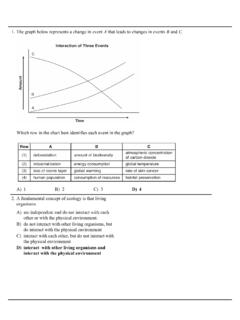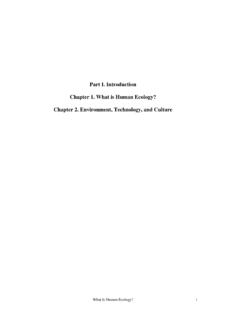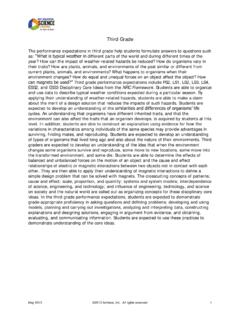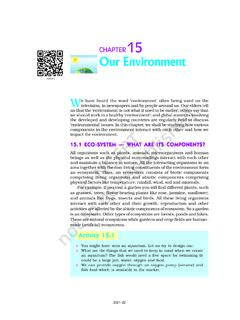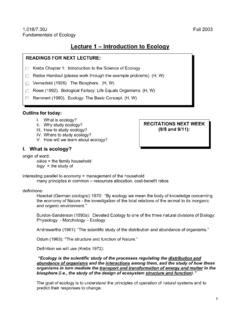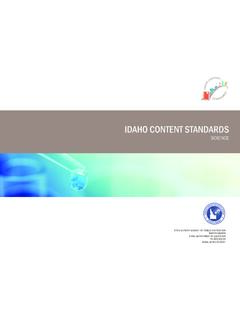Transcription of CHAPTER 2 Interactions in Ecosystems - Miss S. Harvey
1 CHAPTER . Interactions in Ecosystems 2. CHAPTER Preview What do you need to live? How are your needs different from those of other living things on Earth? Where do the things that you need come from? What would happen if something you needed was not available? KEY IDEAS. Life exists almost everywhere on Earth. All life, and Living things are connected to each other in complex everything needed to maintain it, exists within a thin interrelationships. layer of land, sea, and air. While the estimates vary, some scientists believe that as many as 40 million different Biotic and abiotic factors are species may populate the planet. But only about 3 million responsible for shaping a community of living things.
2 Of them have been identified and given a name. Only a few thousand of them have been studied in detail. Nutrients cycle within Ecosystems . Scientists attempt to learn more about each living thing. Energy flows through Ecosystems . But they do not stop there. To fully understand the world of living things, scientists look at how organisms interact with each other and with their environment . No living thing can exist in isolation. Every organism is linked to other organisms on the planet. Trying to understand all of the relationships that exist among different living things, as well as with their surroundings, is the goal of ecology. TRY THIS: Modelling Interactions Skills Focus: communicating, recording In this activity, you will explore the Interactions that one organism 4.
3 Add these organisms , relationships, and factors in your has with the other organisms around it, and with the environment graphic organizer. Connect the Interactions by drawing lines in which it lives. between them and the spider. Materials: notebook or graphic organizer A. In what way is this model of representing interrelationships useful? 1. Create a graphic organizer to represent Interactions between a spider and its environment . B. What are the weaknesses of this type of model for showing interrelationships? 2. Consider what the spider eats. What other organisms might compete with it for the same food? What eats spiders? C. Why are models like this one useful for understanding Consider other relationships as well.
4 Interrelationships among organisms and their environments? 3. Consider the non-living factors that affect the spider. D. The spider is just one organism. What can you predict about modelling Interactions that occur between all of the living things on planet Earth? 20 NEL. Biotic and Abiotic Factors in Ecosystems Ecology is the study of how organisms interact with each other and with their physical environment . Ecologists collect information about living things, and then look for patterns to explain the observations. This is an enormous challenge because there is a tremendous variety of organisms and so many different relationships among them.
5 It is for this reason that Did You KNOW. ? Sounds like Greek to Me! The word ecology comes from two ecologists organize their study into several levels (Figure 1). Greek words: oikos, which means The first and simplest level of organization that ecologists study is a single house, and logos or word, . referring to study. So, ecology is living thing or organism. They study the behaviours, the functions, and the literally the science of studying the body structures that an organism has in order to survive in its habitat, or place where something lives. region in which it lives. For example, they might study how a sea otter captures food or how its body is specialized for the marine habitat.
6 But most organisms do not live as isolated individuals. Usually organisms live as a population (the second level of organization), which is all of the organisms of the same species that share a habitat. Ecologists might study how the number of sea otters in the waters of coastal British Columbia changes over time. But populations interact with other populations of organisms . Figure 1 The study of ecology involves organisms , populations, communities, and Ecosystems . The biosphere includes all of the Ecosystems on Earth. NEL Biotic and Abiotic Factors in Ecosystems 21. STUDY TIP All of the different populations in a particular area interact, forming a Check your understanding.
7 Are you community, which is the third level of organization. The community that able to recall the levels within the lives within the kelp beds off the coast of British Columbia includes many biosphere? If not, reread the main ideas and words in bold, and re- populations of plants, fish, and invertebrates like sea urchins, sea stars, and examine Figure 1, on page 21. sponges. At the community level, an ecologist might study how the number of sea urchins affects the number of sea otters in the kelp bed community. They are interested in ways that internal and external factors affect the size of the populations in a community. To learn more about the An ecosystem, which is the fourth and most complex level of Ecosystems found in British Columbia, go to organization, includes the living community as well as the physical GO environment in which the organisms live.
8 GO. Factors such as the introduction of a new species or a temperature change would have a huge impact on the kelp bed community. An ecosystem is simply a convenient way to look at Interactions between the living and the non-living things in an area. It is not defined by size or complexity. It could be as small as the spaces in a rotting log, or as big as the ocean. You could even think of Earth as one big ecosystem, but because of its complexity it is usually considered on a different level called the biosphere. The biosphere is the total area of Earth where living things are found, including the soil, atmosphere, and ocean. TRY THIS: Make a Model Ecosystem Skills Focus: conducting, recording, communicating, questioning, evaluating In this activity, you will combine living and non-living factors to 3.
9 Add the aquatic plants, snails, and guppies. create your own ecosystem. 4. Place the lid on the jar and seal tightly. Materials: 3 4 L jar with lid, 250 g of sand or gravel, 5. Place the jar in an area where it can receive indirect sunlight 4 5 aquatic snails, 2 small guppies, 4 5 aquatic plants for 1 week. A. What was the purpose of sealing your model ecosystem? Handle glass products with care. Assemble B. What is the source of carbon dioxide that the algae and the equipment where it will stand so that it plants require? does not need to be moved after being filled. C. What is the source of oxygen that the fish and snails require? 1. Place 2 3 cm of sand or gravel into a large jar.
10 D. How do the plants and animals get the necessary nutrients? 2. Fill the jar with tap water to within 5 cm of the top. Let it E. What would happen to the ecosystem if one of the fish died? stand without the lid on for 48 h. There are two types of environmental factors in an ecosystem, the living community and the physical environment . The living components of the ecosystem are called biotic factors. For example, in the kelp beds off the coast of British Columbia the biotic factors include the plants, fish, and invertebrates, as well as the complex Interactions occurring between them. The non-living components, or abiotic factors, include the physical and chemical components in the environment .

